Rare Rides Icons: The History of Imperial, More Than Just a Car (Part XIX)

We return to our Imperial series again today, and the third installment on the all-new personal luxury coupe Lee Iacocca launched in 1981 to resurrect the historical Imperial name. Unlike every other Imperial to date, the new one was available only in two-door coupe guise. The new car had the dual mission of bringing luxury car credibility back to Chrysler, and grabbing some high margin luxury coupe sales from GM and in particular, Lincoln and the Continental Mark VI. We’ve covered the exterior and the underpinnings, so today we slide into the interior, which is most definitely not covered in Rich Corinthian Leather.
Chrysler wanted to step away from the “luxury” advertising it used for its more plebeian cars prior to the ’81 Imperial and would use well into the latter part of the decade. A tuxedoed Ricardo Montalbán (1920-2009) was Chrysler’s spokesperson of choice for many years, and he advertised the company’s wares with flair. He highlighted the decadent exterior and interior details, and the all-important “rich Corinthian leather,” a phrase that didn’t really mean anything. But Montalbán wouldn’t do for Imperial; they’d need a new, different take on luxury.
Like the exterior that shared its doors and front fenders with the contemporary Chrysler Cordoba, the Imperial’s interior was a Cordoba-plus experience. The second-generation Cordoba for 1980 onward used a dash much different from its predecessor. Drivers faced a fairly inclusive set of eight circular pods that reflected all the necessary personal luxury information. In the center was a digital clock Chrysler long branded “Chronometer,” layered atop a Chrysler stereo cassette with equalizer. Lowest on the center stack were the climate control and the oft-used cigarette lighter.
Cordoba’s dash was covered in faux burl walnut paneling, and all gauges and clusters were backed by black trim. Dashboard wood ended just to the right of the center stack, where the padded dash in front of the passenger was color-matched to the interior, and sans wood. A near-vertical glovebox lid was within easy reach of the passenger, and there were two vertically oriented vents.
Overall the Cordoba had a traditional layout, slightly behind the times visually and not really upscale. But such traditional gauges and midmarket luxury looks wouldn’t cut it for Imperial, as it needed to look much more expensive. It needed to look like it was worth its considerable asking price.
Chrysler took the expected gingerbread approach to transform the interior of the Imperial. Additional standard features were the primary customer attractor, but Imperial promised an interior style all its own as well. Headline features were two: An interior designed by Mark Cross, and crystal “ornamentation” by Cartier. A high-end jewelry company, Cartier also applied its name and clocks to Lincoln Designer Series cars for decades (the Town Car was available as a Cartier from 1981 to 2003). Chrysler got in on the action the very same year as Lincoln, as Cartier licensed (prostituted) its name to domestic vehicles with horrible plastic trim.
For Imperial owners there was always some Cartier crystal visible: The hood ornament itself was made by Cartier. Crystal also appeared on the B-pillar, where the opera lamps had crystal Pentastars inset into their trims. In case three crystals weren’t enough there was a fourth on the interior: Cartier produced the crystal at the center of the steering wheel, where it was lovingly and carefully affixed into the high-quality padded vinyl material.
Since Cartier didn’t do interior design, Chrysler contracted with Mark Cross. A producer of high-end leather goods (today a Mark Cross leather travel bag asks $10,000), Mark Cross was founded in 1845. The company started as a maker of horse implements like saddles and then made its way into leather things for humans. After Imperial, Mark Cross went through a difficult period and had various owners until it was shut down at the end of the Nineties by its owner, Sara Lee baked goods. The Mark Cross brand was resurrected in 2011 by a new owner.
The Imperial marketing materials did not make it clear whether Mark Cross designed both the cloth and leather versions of the interior, but only the leather version had Mark Cross insignias. Both cloth and leather-bound Imperials used the same seat design, with tufted and lightly ruched seating materials that were different than those in the Cordoba. Seats included additional metal exterior trim detail not found on Cordoba.
For Mark Cross leather versions, the center armrest was pressed with the company’s logo, and rear passenger door pulls also reflected the Mark Cross lion insignia. The full name of the trim sounded more exclusive in the marketing, as the “Mark Cross Signet Edition.” All Imperials featured a gold key with crystal (by Cartier), but Mark Cross trims had an additional leather fob with a gold keyring. There was also a Mark Cross branded umbrella that was stored underneath the center of the dash. Mark Cross also provided a leather portfolio to hold various ownership papers with style and flair. Cloth seating was called Yorkshire and was offered in six colors versus seven for the Mark Cross.
Aside from the leather designer series distinction, all Imperials were differentiated from the Cordoba by their exclusive digital dash. Imperial was marketed as an “electronic marvel,” which included the unreliable fuel injection developed by former NASA engineers, as well as the new digital dashboard. A digital dash was a requirement in the domestic luxury segment in the early Eighties, as both Lincoln and Cadillac had at least some digital gauges in their luxury offerings by 1981. For Imperial, it was branded as the Electronic Communication Center, and Chrysler boasted that Imperial was the only American car with an entirely digital instrument cluster. Designed by the same engineers who created the EFI, the digital dash was solid-state and had a permanent memory.
The eight gauges from the Cordoba were consolidated into four different electronic pods in Imperial, with various warning lamps underneath. The Chronometer area in Cordoba was swapped for the Communication Center module. The Center contained nine different buttons that controlled the central digital gauges in front of the driver and provided any necessary information. Everything from time and date to the distance driven and average speed. All gauges in front of the driver were angled away and covered with a piece of clear plastic that angled toward the driver. The effect was a glossy, “single computer unit” appearance.
Underneath the Communication Center buttons, there was an upgraded stereo that had electronic balance controls instead of the manual ones in the Cordoba. Four different sound system types were available per customer preference. The climate control was the same unit as in the Cordoba but had a metallic faceplate instead of black.
Generally speaking the buttons and faceplates on Imperial were metallic to add an upscale air and differentiate from Cordoba. Faux wood paneling was of a lighter color than Cordoba and had golden marquetry-type outlines around gauges and center stack pods. The area in front of the passenger was identical to the Cordoba, apart from an Imperial script badge. Power features exclusive to the Imperial for 1981 included electric exterior mirrors, a power trunk release, and a garage door opener.
Unfortunately, the complex and completely digital dash, though ahead of its time, had electrical issues much like the fuel injection. The dash was intended to illuminate when someone pulled the driver’s door and greet the driver with an electronic glowing flourish, but that feature often failed over time. Any bad switch in another part of the interior (for example the lights) could cause the dash to function intermittently or not at all.
The memory function of the dash was designed to keep track of the odometer when the battery was disconnected for whatever reason, or if there was work done on the dash. Early run 1981 cars often had their dashes fail while under warranty. But the dealer’s dash replacement caused an asterisk to illuminate on the new dash, as the car’s memory indicated a discrepancy. The new odometer could not be programmed to read accurately, so any Imperial with a dash replacement became a true mileage unknown vehicle. Fun! Dealers attempted to fix the issue by putting a certification sticker on the driver’s door indicating the true mileage of the Imperial.
But all the world’s electronic whiz-bangery and leather trim couldn’t conceal the Cordoba origins of the Imperial’s interior, or in fact its dated actual source: The R-body. Chrysler’s R platform was a short-lived one, on sale from 1978 to 1981. The R was a downsized attempt at a full-size car at the end of the Seventies, made on a shoestring budget. The Rs weren’t particularly good, nor were they popular.
The platform itself was a derivative of the B-body that was in production since 1962. To create the Cordoba and future Imperial’s interior, Chrysler took the dash from the Dodge St. Regis and siblings and edited it very slightly. In the composition image above, the top interior is from the St. Regis, and the bottom is from a 1980 Cordoba. A little more padding, directional change in the passenger vents, and boom – an interior for the Eighties!
With all its merits, Iacocca knew he needed a hook aside from the Mark Cross name to reach his estimated 25,000 sales per year. So he called up his friend Frank Sinatra, who became quite involved in Imperial at its launch. Next time we’ll talk fs editions, limousines, and sales issues.
[Images: Chrysler]

Interested in lots of cars and their various historical contexts. Started writing articles for TTAC in late 2016, when my first posts were QOTDs. From there I started a few new series like Rare Rides, Buy/Drive/Burn, Abandoned History, and most recently Rare Rides Icons. Operating from a home base in Cincinnati, Ohio, a relative auto journalist dead zone. Many of my articles are prompted by something I'll see on social media that sparks my interest and causes me to research. Finding articles and information from the early days of the internet and beyond that covers the little details lost to time: trim packages, color and wheel choices, interior fabrics. Beyond those, I'm fascinated by automotive industry experiments, both failures and successes. Lately I've taken an interest in AI, and generating "what if" type images for car models long dead. Reincarnating a modern Toyota Paseo, Lincoln Mark IX, or Isuzu Trooper through a text prompt is fun. Fun to post them on Twitter too, and watch people overreact. To that end, the social media I use most is Twitter, @CoreyLewis86. I also contribute pieces for Forbes Wheels and Forbes Home.
More by Corey Lewis
Latest Car Reviews
Read moreLatest Product Reviews
Read moreRecent Comments
- Ajla IMO, something like this really should be naturally-aspirated.
- Kjhkjlhkjhkljh kljhjkhjklhkjh Unless they are solid state batteries you BAN THEM. I like EVs... but EVs like to burn ... for days
- Kjhkjlhkjhkljh kljhjkhjklhkjh uh .. it looks like a VW golf got the mumps
- Kjhkjlhkjhkljh kljhjkhjklhkjh I CANNOT WAIT FOR SOCIAL SECURITY TO GET GUTTED.. No i am really serious. I am insulated thanks to 24 years at Symantec then Broadcom .. tons of retirement cash. but all the blue hairs and low income trump voters are going to lose benefits and jobs and i get to laugh allllll dayyyyy long in about 2-3 years.. CANNOT WAIT, POPCORN READY.
- Kjhkjlhkjhkljh kljhjkhjklhkjh no. to many '''''americans'''' just want a CUV or SUV according to sales numbers



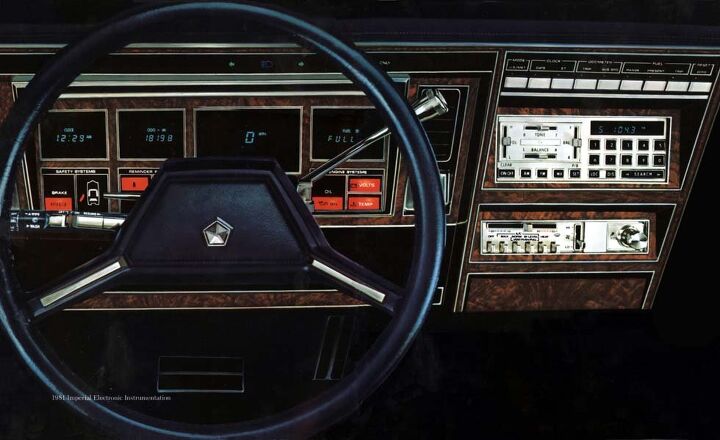



























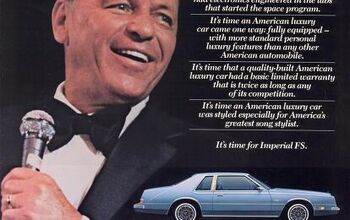
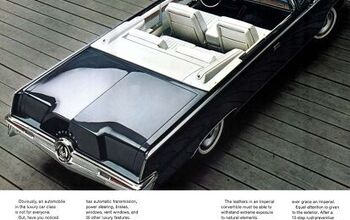
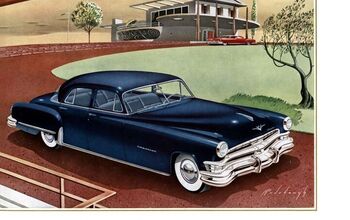
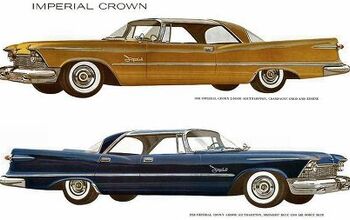
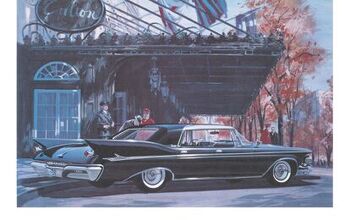










Comments
Join the conversation
I'm not really sure that the interiors of the competing all that much better. A little better, maybe, but these were dark times.
The racing mention up-top reminds me that there was a Pennzoil commercial where an IndyCar driver went blasting around his wife at the Brickyard, and she was driving a yellow Imperial. Johnny Rutherford, maybe?